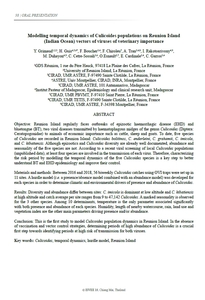Grimaud Yannick, Guis Hélène, Boucher Floriane, Chiroleu Frédéric, Tran Annelise, Rakotoarivony Ignace, Duhayon Maxime, Cetre-Sossah Catherine, Esnault Olivier, Cardinale Eric, Garros Claire.
2018. Modelling temporal dynamics of Culicoides populations on Reunion Island (Indian Ocean) vectors of viruses of veterinary importance.
In : Abstract Book of the 15th International Symposium of Veterinary Epidemiology and Economics (ISVEE 15). ISVEE
![[img]](http://agritrop.cirad.fr/589829/1.hassmallThumbnailVersion/AbstractGrimaud.jpg)
|
Version publiée
- Anglais
Utilisation soumise à autorisation de l'auteur ou du Cirad. AbstractGrimaud.jpg Télécharger (454kB) | Prévisualisation |
Résumé : Objective: Reunion Island regularly faces outbreaks of epizootic haemorrhagic disease (EHD) and bluetongue (BT), two viral diseases transmitted by haematophagous midges of the genus Culicoides (Diptera: Ceratopogonidae) to animals of economic importance such as cattle, sheep and goats. To date, five species of Culicoides are recorded in Reunion Island: Culicoides bolitinos, C. enderleini, C. grahamii, C. imicola, and C. kibatiensis. Although epizootics and Culicoides diversity are already well documented, abundance and seasonality of the five species are not. According to a recent viral screening of local Culicoides populations (unpublished data), at least four species are involved in the transmission of each virus. Therefore, characterizing the risk period by modelling the temporal dynamics of the five Culicoides species is a key step to better understand BT and EHD epidemiology and improve their control. Materials and methods: Between 2016 and 2018, 56 biweekly Culicoides catches using OVI traps were set up in 11 sites. A hurdle model (i.e. a presence/absence model combined with an abundance model) was developed for each species in order to determine climatic and environmental drivers of presence and abundance of Culicoides. Results: Diversity and abundance differ between sites: C. imicola is dominant at low altitude and C. kibatiensis at high altitude and catch average per site ranges from 9 to 47,142 Culicoides. A marked seasonality is observed for the 3 other species. Among 10 determinants, temperature is the only parameter associated significantly with both presence and abundance of each species. Humidity, length of nearby watercourse, rain, land use and vegetation index are the other main parameters driving presence and/or abundance. Conclusion: This is the first study to model Culicoides population dynamics in Reunion Island. In the absence of vaccination and vector control strategies, determining periods of high abundance of Culicoides is a crucial first step towards identifying periods at high risk of transmission for both viruses.
Mots-clés libres : Culicoides, Temporal dynamics, Hurdle model, Reunion Island
Auteurs et affiliations
- Grimaud Yannick, CIRAD-BIOS-UMR ASTRE (REU)
-
Guis Hélène, CIRAD-BIOS-UMR ASTRE (MDG)
 ORCID: 0000-0002-0355-0898
ORCID: 0000-0002-0355-0898
- Boucher Floriane, CIRAD-BIOS-UMR ASTRE (REU)
-
Chiroleu Frédéric, CIRAD-BIOS-UMR PVBMT (REU)
 ORCID: 0000-0002-4874-5357
ORCID: 0000-0002-4874-5357
-
Tran Annelise, CIRAD-ES-UMR TETIS (REU)
 ORCID: 0000-0001-5463-332X
ORCID: 0000-0001-5463-332X
-
Rakotoarivony Ignace, CIRAD-BIOS-UMR ASTRE (FRA)
 ORCID: 0009-0002-3480-6734
ORCID: 0009-0002-3480-6734
- Duhayon Maxime, CIRAD-BIOS-UMR ASTRE (FRA)
- Cetre-Sossah Catherine, CIRAD-BIOS-UMR ASTRE (REU)
- Esnault Olivier, GDS Réunion (REU)
-
Cardinale Eric, CIRAD-BIOS-UMR ASTRE (REU)
 ORCID: 0000-0002-3434-3541
ORCID: 0000-0002-3434-3541
-
Garros Claire, CIRAD-BIOS-UMR ASTRE (REU)
 ORCID: 0000-0003-4378-5031
ORCID: 0000-0003-4378-5031
Source : Cirad-Agritrop (https://agritrop.cirad.fr/589829/)
[ Page générée et mise en cache le 2025-02-27 ]





